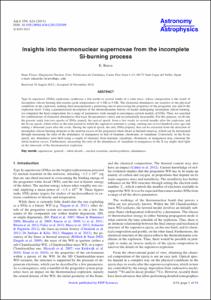Mostra el registre d'ítem simple
Insights into thermonuclear supernovae from the incomplete Si-burning process
| dc.contributor.author | Bravo Guil, Eduardo |
| dc.contributor.other | Universitat Politècnica de Catalunya. Departament de Física i Enginyeria Nuclear |
| dc.date.accessioned | 2013-01-21T14:54:24Z |
| dc.date.available | 2013-01-21T14:54:24Z |
| dc.date.created | 2013-01-21 |
| dc.date.issued | 2013-01-21 |
| dc.identifier.citation | Bravo, E. Insights into thermonuclear supernovae from the incomplete Si-burning process. "Astronomy and astrophysics", 21 Gener 2013, vol. 550, p. 1-16. |
| dc.identifier.issn | 0004-6361 |
| dc.identifier.uri | http://hdl.handle.net/2117/17442 |
| dc.description.abstract | Type Ia supernova (SNIa) explosions synthesize a few tenths to several tenths of a solar mass, whose composition is the result of incomplete silicon burning that reaches peak temperatures of 4 GK to 5 GK. The elemental abundances are sensitive to the physical conditions in the explosion, making their measurement a promising clue to uncovering the properties of the progenitor star and of the explosion itself. Using a parameterized description of the thermodynamic history of matter undergoing incomplete silicon burning, we computed the final composition for a range of parameters wide enough to encompass current models of SNIa. Then, we searched for combinations of elemental abundances that trace the parameters values and are potentially measurable. For this purpose, we divide the present study into two epochs of SNIa, namely the optical epoch, from a few weeks to several months after the explosion, and the X-ray epoch, which refers to the time period in which the supernova remnant is young, starting one or two hundred years age and ending a thousand years after the event. During the optical epoch, the only SNIa property that can be extracted from the detection of incomplete silicon burning elements is the neutron excess of the progenitor white dwarf at thermal runaway, which can be determined through measuring the ratio of the abundance of manganese to that of titanium, chromium, or vanadium. Conversely, in the X-ray epoch, any abundance ratio built using a couple of elements from titanium, vanadium, chromium, or manganese may constrain the initial neutron excess. Furthermore, measuring the ratio of the abundances of vanadium to manganese in the X-ray might shed light on the timescale of the thermonuclear explosion. |
| dc.format.extent | 16 p. |
| dc.language.iso | eng |
| dc.subject | Àrees temàtiques de la UPC::Física::Termodinàmica |
| dc.subject.lcsh | Thermodynamic |
| dc.title | Insights into thermonuclear supernovae from the incomplete Si-burning process |
| dc.type | Article |
| dc.subject.lemac | Termodinàmica |
| dc.identifier.doi | 10.1051/0004-6361/201220309 |
| dc.description.peerreviewed | Peer Reviewed |
| dc.relation.publisherversion | http://www.aanda.org/index.php?option=com_article&access=doi&doi=10.1051/0004-6361/201220309&Itemid=129 |
| dc.rights.access | Open Access |
| local.identifier.drac | 11212762 |
| dc.description.version | Postprint (published version) |
| local.citation.author | Bravo, E. |
| local.citation.publicationName | Astronomy and astrophysics |
| local.citation.volume | 550 |
| local.citation.startingPage | 1 |
| local.citation.endingPage | 16 |
Fitxers d'aquest items
Aquest ítem apareix a les col·leccions següents
-
Articles de revista [603]


